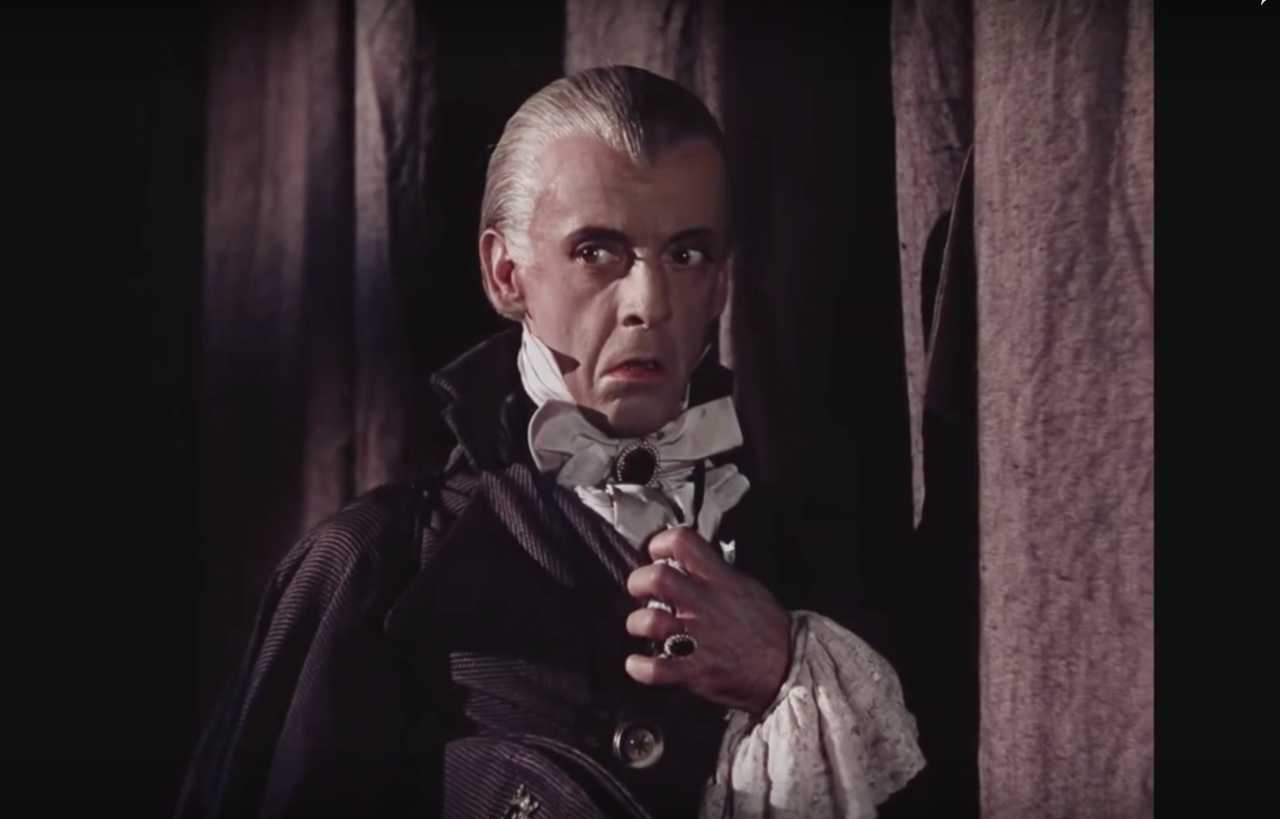I first fell in love with the cinema at age three when I saw “The Sound of Music.” In the film, Julie Andrews plays Maria, a nun who becomes a governess, and subsequently teaches her seven charges the fundamentals of music — do-re-mi. She believes that it is best to “start at the very beginning,” since “it’s a very good place to start.”
Maria’s advice is particularly apt during this time of year. After all, New Student Orientation (NSO) is the beginning of a Stanford education. As Stanford’s website states, NSO is an opportunity to “introduce undergraduate students … to the wide array of academic, intellectual, leadership, cultural, and social experiences available at Stanford.” This is “a time to settle into your room, make friends, and prepare for classes.”
Interestingly, this definition of NSO recalls screenwriter William Goldman’s description of the beginning of a film. Just as NSO allows freshmen to acclimate to college life and the Stanford campus, the opening of a film gives an artist “time to set up [his] situation … [and his] particular world.” Just as NSO is “a time [to]… make friends,” the beginning of a film affords its creator “time to set up [his] people.”
The opening minutes of a movie may seem incidental in light of the subsequent drama that unfolds. Yet, Goldman, who won two Oscars for screenwriting, actually believed that the beginning was the single most important scene in the film. In his seminal book “Adventures in the Screen Trade,” he claims that “the first fifteen minutes are the most important of any screenplay.” He explains that most studio executives have to read “a sludge pile of scripts.” Therefore, they do not have time to dwell on each page of the screenplay. When they finish perusing the first fifteen pages of a writer’s work, they “will either be hooked or bored.” If they are hooked, they will continue reading. If they are bored, “the ball game’s over.”
While Goldman is focused on selling screenplays to studio executives, his reasoning also applies to the audience. While studio executives spend money to make movies, viewers invest their time in watching a film. After reading the first few pages of a screenplay, an executive determines whether a project is viable. Similarly, in the first few minutes of a film, viewers decide whether they want to hear the rest of an artist’s story. Furthermore, creating a compelling beginning is not the responsibility of the screenwriter alone. Film is primarily a visual medium. Directors transform a stirring screenplay into stellar cinema. By choosing specific shots and cuts, they achieve the same effect as the screenwriter.
Indeed, by starting at the very beginning, we can see what makes a film great. George Cukor’s “The Philadelphia Story,” Martin Scorsese’s “Taxi Driver,” and Stanley Kubrick’s “Barry Lyndon” are all superb films because they have strong starts. In their opening scenes, Cukor, Scorsese, and Kubrick establish their stories, make us care about their characters and differentiate their styles from those of other filmmakers.
If we accept Goldman’s criteria as a guide, Cukor’s “The Philadelphia Story” has an exemplary opening. In two minutes, Cukor introduces his protagonists and his plot. His film focuses on a socialite, Tracy Lord (Katharine Hepburn). After her marriage to the charming C.K. Dexter Haven (Cary Grant) falls apart, she becomes engaged to an odious coal baron. Dexter, however, is still in love with his ex-wife. Therefore, he visits her on her wedding day. Accompanied by an intrepid reporter (James Stewart), he tries to stop her impending marriage.
“The Philadelphia Story” was based on a Broadway play by Phillip Barry. The play opens abruptly, but when Cukor started to direct the film version, he realized that Barry’s opening was not suited to cinema. Audiences needed to understand the personalities of the two protagonists. They had to know that Tracy and Dexter were once married, and that Tracy was planning to remarry.
To convey this information, Cukor simply added a two-minute scene to the start of Barry’s play. The opening credits of the film are superimposed over paintings of Independence Hall, the Liberty Bell, and a statue of Benjamin Franklin. The symbols of Philadelphia establish the setting. Next, Cukor inserts a shot of a stately two-story mansion. On the soundtrack, Franz Waxman’s lush, melodic theme plays. This story is not about average Philadelphians, but instead about the elite. They live in a world suffused with elegance, glamour and taste.
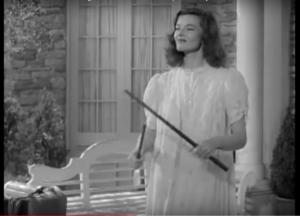
Cukor shows Dexter walking across the portico of the home to his car. He is carrying two suitcases, and another stack of luggage sits beside the car. He looks nervously behind him as the door flings open and Tracy emerges, wearing a white gown. Her hair billows in the wind. She appears pure and free, but she is holding a basket and some golf clubs. Perhaps she is coming to say goodbye to her husband before he leaves on a trip. She takes a golf club out of the bag, however, and throws the rest of them at him. Tracy takes her golf club and splits it in two over her knee, as if to suggest the dissolution of their union. Thus, perhaps Dexter and Tracy are not the epitome of a happy high society couple. Furthermore, even Cukor before inserts a title card reading “two years later,” we know that these events took place before the main action of the film, because they are done entirely in pantomime. Just as the silent era preceded the arrival of sound in Hollywood, this silent sequence comes before the scenes dependent on witty banter.
Still, both this opening scene and the ones that follow are undeniably comic. After watching two minutes of the film, it becomes clear that this is not a hard-edged expose on the lives of the rich. Instead, it is a light, charming diversion. Furthermore, because Dexter and Tracy are acting like slapstick comedians, they do not seem above reproof. While they may be wealthy, they are essentially flawed, silly human beings.
Martin Scorsese’s “Taxi Driver” could not be described as a light, charming diversion. Yet, like Cukor, Scorsese cultivates empathy for his protagonist. The people, situation, and world of Taxi Driver is much less complicated than that of Cukor’s “The Philadelphia Story.” The titular character in Scorsese’s film is the discontented Travis Bickle. He is afflicted with insomnia, so every night, he traverses the streets of a filthy New York City. A lesser director might have communicated this information in a quicker way. He could have simply shown Travis driving his taxi, passing various New York landmarks. Still, Scorsese is not particularly concerned with a specific location in New York, nor is he interested in documenting the actual work a taxi driver does. No passengers climb into Travis’s cab during the duration of the opening.
Instead, Scorsese encourages his audience to identify with Travis. In order for the film to be successful, viewers must see him as a conflicted individual as well as a cabbie. Therefore, Scorsese renders Travis’ situation in stark terms. He sees the city as a kind of hell and portrays Travis as a modern-day avenging angel. The film opens with a shot of smoke. Thick, white, and opaque, it emerges from an unseen, but diabolical inferno. The smoke diffuses as Travis’s taxi passes through it. The taxi appears to be less of a car and more of a mechanical monster, because Scorsese captures it from a low angle. Its arrival is a momentous event.
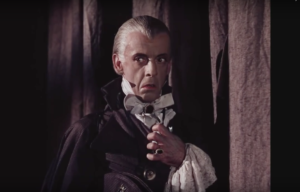
By introducing the taxi in this way, Scorsese enhances the stature of the man commanding it. Our first glimpses of Travis confirm that he is far from ordinary. His eyes reflect the artificial lights of the city, and they dart left and right, left and right. Scorsese has stated that the inspiration for this shot came from Michael Powell and Emeric Pressburger’s “The Tales of Hoffmann.” This 1951 film features a devil, played by the dancer Robert Helpmann. Helpmann’s eyes are like Travis’s, moving back and forth like pendulums. By connecting Travis to Helpmann, Scorsese strengthens his contention that the city is a modern incarnation of Hades.
Then, Scorsese shows us what Travis sees through the windshield of the taxi. It is raining outside. The windshield wipers are working, but they move languidly across the glass. Therefore, everything outside seems distorted. The crowded streets transform into a Fauvist landscape. The red neon lights blend into the yellow glare of the streetlights and the white haze of a movie theatre marquee. While Travis travels down various streets, they seem to blur together too. Only Travis can make sense of this indistinct metropolis. Thus, we are willing to accompany him on his journey.
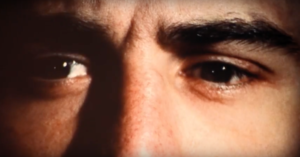
For some directors, introducing their idiosyncratic style can be more important than introducing a single character. Stanley Kubrick’s “Barry Lyndon” is based on a novel by William Makepeace Thackeray, and it chronicles the adventures of the titular Irish rogue. Barry travels throughout 18th-century Europe. He visits the court of King George III, fights in the Seven Years’ War, drinks in the taverns of the common man, and plays cards with England’s upper crust. Kubrick, however, seems more concerned with the story’s historical setting than with Barry’s escapades. The film could be classified as a period piece, rather than a character study.
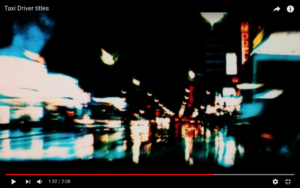
Of course, the period piece has been a staple of the cinema since its early days. Like many directors of costume dramas, Kubrick strives for authenticity. While making the film, he took great pains to ensure that his actors were clothed in authentic attire. He wanted them to appear and speak like King George’s citizens. He also eschewed the use of electric lights during production. Only candles illuminated Kubrick’s set. They filled the set with smoke, and therefore, Kubrick was able to accurately capture the shadowy spaces of Georgian England. In composing his shots, he took inspiration from the great English artists of the era, including John Constable and William Hogarth.
Yet, for all his efforts to bring the past back to life, Kubrick would probably agree with the writer L.P. Hartley’s assertion that “the past is a foreign country; they do things differently there.” While other directors seek to immerse their audiences in an earlier time, Kubrick never allows his audience to truly feel as if they live in the 18th-century. He employs a narrator throughout the entire film. This unnamed personage speaks in voice-over, relating key events in the past tense. Furthermore, Kubrick often chooses to shoot scenes in a wide shot. By placing his camera far away from the subjects in a frame, Kubrick puts physical distance between his viewers and his characters. While we can observe Barry and his compatriots, we do not become intimately involved with them. Critic Pauline Kael called the film “a three-hour slideshow for art history majors,” and indeed, the experience of watching Barry Lyndon is similar to the effect you feel looking at a picture. You admire its beauty, but you are constantly aware that you are separated from it by the frame and the surface of the canvas.
Kubrick’s perception of the past is apparent in the first few seconds of the film. After the credits, some text appears. As we listen to a Handel march on the soundtrack, we are informed that we are about to see “Part I: By What Means Redmond Barry Acquired the Style and Title of Barry Lyndon.” Then, Kubrick presents a shot of the English countryside. A rustic, stone fence bisects the frame. Empty space lies on the right-side of the fence, but on the left, some figures appear in the distance. The composition of the frame is reminiscent of a John Constable painting. Constable often painted picturesque scenes of the English countryside. On the eve of the Industrial Revolution, he emphasized the supremacy of nature over man. In paintings like “Fen Lane, East Bergholt” (1817), Constable rendered a pristine landscape in vivid, verdant hues. He populated the backgrounds of these paintings with tiny figures. Usually, these miniscule individuals were simply going about their mundane chores.
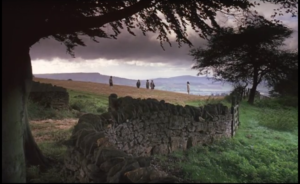
While Kubrick’s frame resembles Constable’s paintings in its composition, Kubrick’s individuals are not carrying out a routine task. Instead, they are dueling. Distantly, we hear a man shouting “gentlemen, cock your pistols!” Then, the narrator intones that “Barry’s father had been bred, like many other sons of a genteel family, to the profession of the law, and there is no doubt he would have made an eminent figure in his profession, had he not been killed in a duel, which arose over the purchase of some horses.” The pistols are fired, and the narrator’s words are borne out. Barry’s father falls to the ground in a heap. His death is no doubt a dramatic event, but since Kubrick refuses to show us his face, it is difficult to empathize with Barry’s father as he expires.
Still, Kubrick does not seek to evoke pathos from us, but instead call our attention to the larger world he has created. By linking his style to John Constable’s and employing the narrator, he reminds us that we are looking at something that has already happened. No matter how engrossed we become in Barry’s story, we cannot do anything to change it. We are simply viewers, watching history unfold. Kubrick relays some information about his protagonist, expresses his style, and tells us what our role in the story is, all within the first shot of the film.
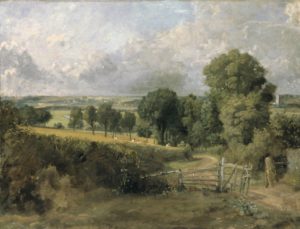
Indeed, in these first scenes, Kubrick, Scorsese, and Cukor all demonstrate their skillful command of cinematic techniques. Yet, these openings are not just impressive in and of themselves. As Goldman writes, “a screenplay … is a series of surprises. We detonate these as we go along. But for a surprise to be valid, we must set the ground rules, indicate expectations.” In these beginnings, the directors establish the ground rules by introducing their characters, setting and style. Then, they build upon these foundations to forge great experiences at the movies. By exposing the foibles of his characters at the beginning, Cukor encourages us to laugh at their staggering mistakes later in the picture. By making us feel sympathy with a taxi driver, Scorsese compels us to follow him as he roams the streets of the corrupt city. By immersing us in his gilded 18th-century world, Kubrick is able to confront the complexities of a pivotal period in history.
Students who are coming to Stanford have much more on their minds than the movies. Between moving in, meeting new friends, and participating in introductory events, members of the class of 2022 have little time to entertain cinematic flights of fancy. Still, just as these masters of cinema are able to lay the foundations for masterpieces in their opening minutes, in this week, members of the class of 2022 are not just getting acclimated. As they start at the very beginning, they are setting out to create a stellar Stanford experience, suffused with surprises.
Contact Amir Abou-Jaoude at amir2 ‘at’ stanford.edu.
